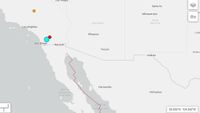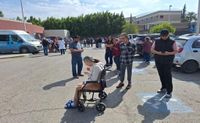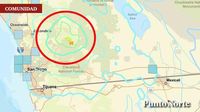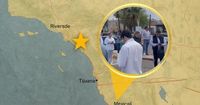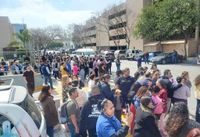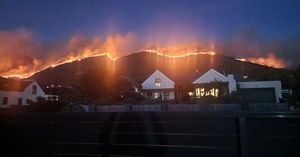A strong earthquake measuring 5.2 on the Richter scale struck at 10:08 AM on Monday, April 14, 2025, shaking several municipalities in Baja California, Mexico. The tremor was felt most intensely in Tijuana and Mexicali, prompting families to evacuate their homes and leading to preventive evacuations in public sector and government offices.
According to the United States Seismological Service, the earthquake's epicenter was located 4 kilometers south of Julian, a mountainous town in San Diego County, California. The exact timing of the earthquake was recorded at 10:08:28 AM local time. Governor Marina del Pilar Ávila Olmeda issued a brief statement via social media, confirming that Civil Protection authorities were assessing potential impacts across various municipalities in the state.
“Bajacalifornianas y bajacalifornianos, hace un momento se registró un sismo de magnitud preliminar de 6.0 grados. El mismo tuvo lugar a las 10:08 am con epicentro en el condado de San Diego, California, en Estados Unidos, el mismo se percibió en nuestro estado,” the governor warned, reminding residents of the region’s seismic activity. She urged citizens to identify emergency exits, have contact numbers for family members readily available, and prepare an emergency kit with essential supplies.
Reports indicated that after the initial quake, nearly a dozen aftershocks occurred, none exceeding 3.0 on the Richter scale. The earthquake's impact reached municipalities such as Tijuana, Playas de Rosarito, and Ensenada, where authorities evacuated hundreds from government buildings as part of emergency protocols.
Infrastructure damage has been reported, particularly in the Municipal Palace of Tijuana and the Tax Collection office in Tecate, as well as in private offices. In Tijuana, Denisse Barajas was present in the SAT building during the quake, where staff prioritized evacuating people with disabilities and the elderly.
While no serious injuries or significant structural damage were reported immediately following the earthquake, the Municipal Civil Protection Department continued to monitor the situation closely. “Protección Civil se encuentra en este momento registrando posibles afectaciones en los distintos municipios de nuestro estado,” Governor Ávila Olmeda reiterated.
The earthquake was classified as shallow, occurring at a depth of 13 kilometers, which is typical for seismic events that are felt strongly over considerable distances. This shallow depth likely contributed to the quake being felt not only in Tijuana and Mexicali but also in various cities across Southern California, including Los Angeles, Anaheim, and Long Beach.
Many residents took to social media to share their experiences and reactions. Reports from users in Tijuana noted that the quake was felt strongly, with one user stating, “se sintió feo” (it felt bad). Maps of the epicenter and alerts from various seismic monitoring apps were also circulated online.
In Mexicali, at least one hospital unit evacuated its healthcare personnel as a precautionary measure, while several government agencies initiated structural assessments of their facilities. Local authorities urged the public to remain vigilant and attentive to updates from official sources, including the USGS and Baja California Civil Protection.
The initial magnitude estimates varied slightly among different seismic agencies. The USGS reported a preliminary magnitude of 5.1, while the European-Mediterranean Seismological Centre (EMSC) had not confirmed the magnitude but located the epicenter near Alpine, California. Meanwhile, Alerta Mundial reported a magnitude of 5.4. Such discrepancies are common in the immediate aftermath of seismic events as agencies refine their data.
Governor Ávila Olmeda emphasized the importance of preparedness in a seismic zone, reminding residents to keep emergency kits ready and to stay informed about safety measures in case of future earthquakes. “Es importante tener en cuenta que se pueden presentar posibles réplicas del sismo por lo que hay que permanecer alertas,” she advised, stressing the need for ongoing vigilance.
As the situation develops, local authorities continue to assess the effects of the earthquake and provide necessary updates to the public. The 911 emergency line remains active to address any emergencies 24 hours a day, ensuring that residents have access to immediate assistance if needed.
This earthquake serves as a reminder of the seismic risks faced by communities in Baja California and Southern California, highlighting the need for preparedness and effective emergency response measures.
